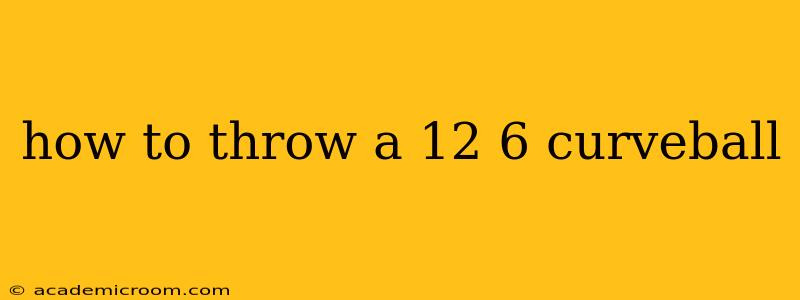How to Throw a 12-6 Curveball: A Comprehensive Guide
The 12-6 curveball, known for its sharp, dramatic break, is a highly sought-after pitch in baseball. Mastering this pitch requires dedication, practice, and a good understanding of the mechanics involved. This guide will break down the key elements, addressing common questions and offering tips for improvement.
What Makes a 12-6 Curveball Different?
The "12-6" refers to the direction of the break. Imagine a clock face on the catcher's mitt; a 12-6 curveball breaks down (6 o'clock) and away from a right-handed hitter (towards 12 o'clock). This significant drop is what makes it so effective, deceiving hitters by making the ball appear to be a fastball until late in its trajectory. Other curveballs might have a more sweeping break (e.g., a slider).
How to Grip a 12-6 Curveball
The grip is crucial for generating the necessary spin. The most common grip involves placing your index and middle fingers across the seams on the top of the baseball, while your thumb rests underneath. The pressure you apply to the ball, particularly with your fingers, influences the break. Experiment to find the grip that feels most comfortable and produces the desired movement.
What is the Proper Throwing Mechanics for a 12-6 Curveball?
Throwing a 12-6 curveball effectively requires a different arm action compared to a fastball.
- Grip Pressure: Maintain firm grip pressure throughout the throwing motion. Releasing too early can reduce the break.
- Wrist Snap: A pronounced wrist snap is essential. This is what imparts the spin and creates the downward break. Practice snapping your wrist downward and inward as you release the ball.
- Arm Angle: A slightly lower arm slot than your fastball can enhance the break. Experiment with different arm angles to find what works best for you.
- Throwing Motion: The overall throwing motion should be similar to your fastball, but with a deliberate focus on the wrist snap and the slower arm speed. Throwing too hard will often result in a less effective curveball.
How Much Slower Should My Curveball Be Than My Fastball?
The speed differential between your fastball and curveball is key. A good rule of thumb is to throw your curveball approximately 10-15 mph slower than your fastball. This creates a significant deception for the hitter. However, this speed difference can vary depending on individual arm strength and mechanics.
What are Common Mistakes When Throwing a 12-6 Curveball?
- Throwing too hard: This reduces the break and can lead to inaccuracy. Focus on control and spin rather than velocity.
- Inconsistent grip: A consistent grip is crucial for repeatable results. Practice the grip until it becomes second nature.
- Lack of wrist snap: A weak wrist snap results in a less effective curveball. Focus on the wrist snap as the primary force behind the pitch's break.
- Throwing from too high an arm slot: A lower arm slot can help increase the downward break.
How Can I Improve My 12-6 Curveball?
Consistent practice is key to mastering any pitch. Start by throwing the curveball slowly, focusing on the proper grip and wrist snap. Gradually increase your velocity as your control improves. Use a pitching machine or have a friend catch to refine your accuracy and consistency. Consider working with a pitching coach to analyze your mechanics and identify areas for improvement. Video recording your pitches can also help you identify subtle issues in your form.
How Long Does It Take to Master a 12-6 Curveball?
Mastering the 12-6 curveball is a process that requires time and patience. Some pitchers may see results relatively quickly, while others may take months or even years to fully develop the pitch. Consistency in practice and attention to detail are critical to long-term success. Don't get discouraged if you don't see immediate results – keep practicing and refining your technique.
By understanding the grip, mechanics, and common mistakes, and through dedicated practice, you can significantly improve your chances of throwing a devastating 12-6 curveball. Remember, consistent practice and attention to detail are key to mastery.
